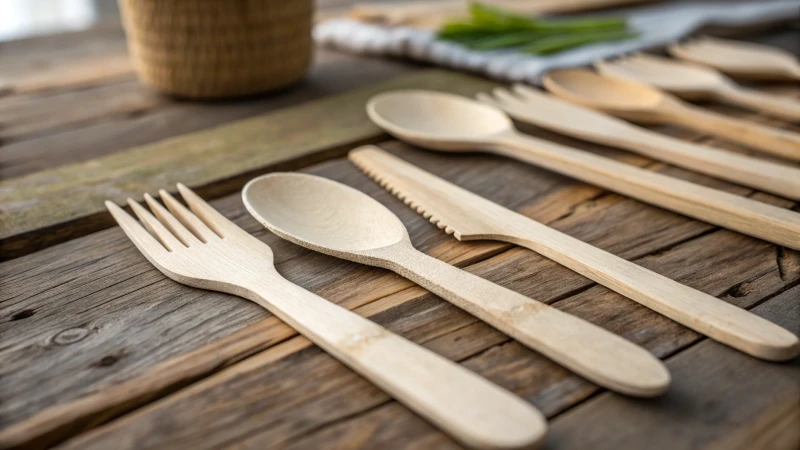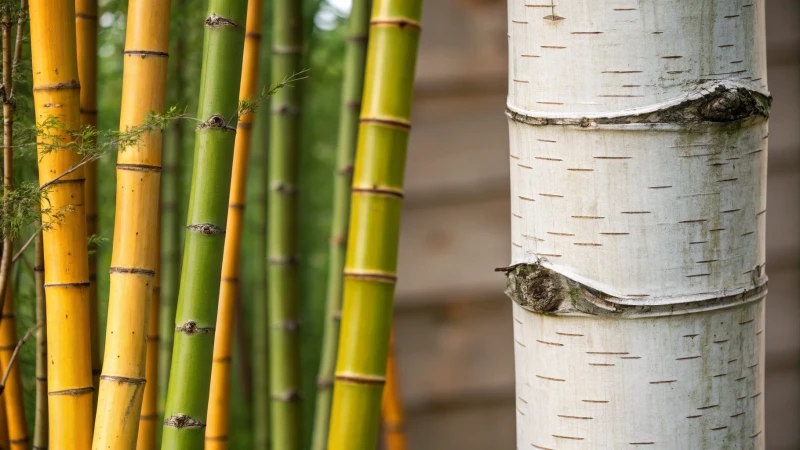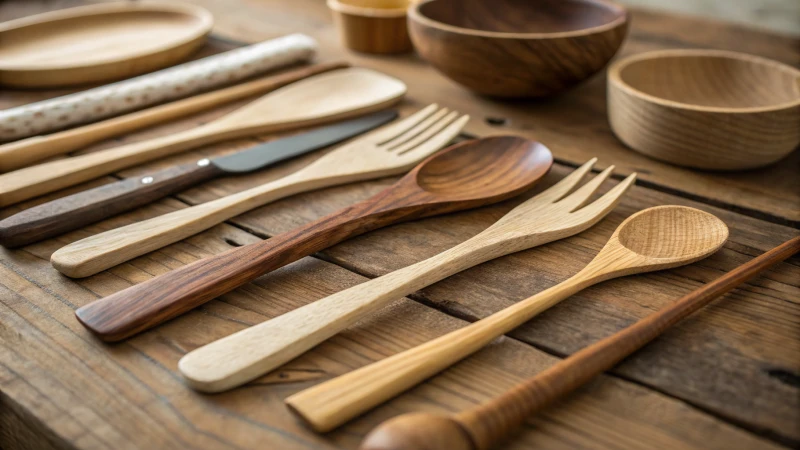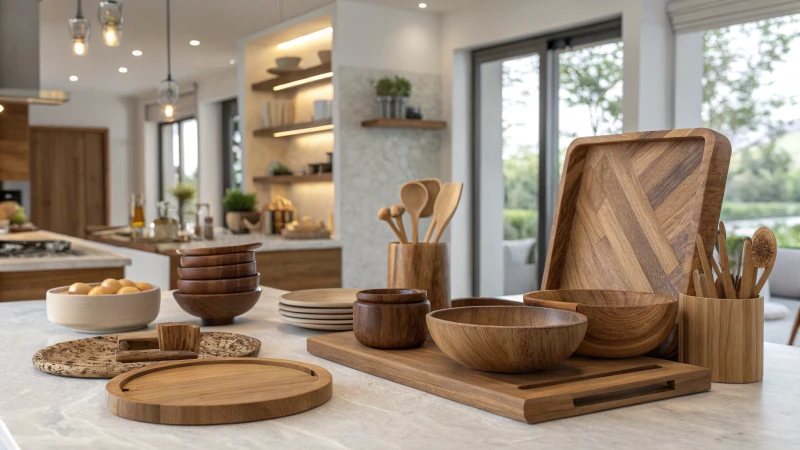
Ever picked up a wooden fork and wondered about its journey from tree to table?
The type of wood used in disposable wooden cutlery greatly affects its durability and strength. Hardwoods, such as birch, are known for their toughness, while softwoods like bamboo offer a sustainable alternative with sufficient resilience. Choosing the right wood ensures your cutlery is both functional and environmentally friendly.
Understanding the nuances between different woods can really help if you're trying to make an eco-conscious decision. I remember a time when I switched from plastic to wooden cutlery at an event. The feel of the birch knife was sturdy and reliable, unlike some bamboo options that felt less robust but were undeniably greener. Learning about the specific characteristics of each wood type allows you to align your choices with both your functional needs and sustainability goals. It's not just about picking any wooden spoon; it's about finding the one that matches your values and needs.
Hardwoods like birch make more durable cutlery than softwoods.True
Birch is a hardwood known for its durability, making it ideal for cutlery.
Bamboo cutlery is less eco-friendly than birch cutlery.False
Bamboo is highly renewable, making it an eco-friendly choice despite being a softwood.
What Are the Most Commonly Used Woods for Disposable Cutlery?
Ever wondered what makes wooden disposable cutlery both eco-friendly and practical? Let’s dive into the most popular woods used and why they’re a hit.
Bamboo and birch are the top choices for disposable cutlery. Bamboo is sustainable due to its quick growth, while birch offers strength and a smooth finish, appealing to eco-conscious buyers.

Understanding the Materials: Bamboo vs. Birch
I remember the first time I held a bamboo fork at a friend's picnic. It felt light yet surprisingly sturdy, and I was intrigued by its sustainable nature. Bamboo1, with its ability to grow back in mere months, seemed like nature's gift to our eco-conscious generation. It's not just about being green; it's about being practical. Bamboo combines strength with lightweight usability, making it a go-to for those of us who care about the environment but also need something reliable.
Then there's birch, which feels like the classic choice when you think of wooden cutlery. Its smooth texture and solid feel make it perfect for a natural dining experience. I've always appreciated birch for its aesthetic appeal—it just looks and feels premium without the hefty processing. Plus, knowing it’s biodegradable and compostable aligns with many green initiatives2 that I try to support in my everyday choices.
| Wood Type | Characteristics | Sustainability |
|---|---|---|
| Bamboo | Fast-growing, strong, lightweight | High |
| Birch | Smooth finish, sturdy, natural look | Moderate |
Choosing the Right Wood for Your Needs
Deciding on the right wood can feel like choosing the perfect outfit for a big event—it has to fit just right. For businesses prioritizing sustainability, bamboo is often the hero. Its rapid renewability is not only impressive but also aligns perfectly with environmental goals and resonates with eco-conscious consumers like me.
But if you're like me and aesthetics play a role in your decision-making process, birch stands out. Its polished finish adds a touch of elegance to any meal, whether it's a casual backyard BBQ or a more formal event. Plus, its strength ensures reliability—I’ve never had a birch fork snap on me during use!
Customization is another key factor. Both bamboo and birch can be laser-etched or printed on to match specific themes or corporate identities. It's always fun to see how businesses can make something as simple as cutlery an extension of their brand.
Balancing Cost and Quality
Of course, budget plays a significant role. Bamboo might be more cost-effective due to its abundance, but sometimes spending a bit more on birch can be justified by its durability and classy appearance. It's all about finding that sweet spot between quality and cost that best suits your needs.
Understanding these nuances can help businesses and individuals alike make informed choices that align with both product positioning3 and customer expectations.
Bamboo is more sustainable than birch for cutlery.True
Bamboo grows rapidly, replenishing quickly, unlike birch.
Birch is less durable than bamboo for utensils.False
Birch offers sturdiness and a smooth finish, ensuring durability.
How Do Bamboo and Birch Compare in Durability and Sustainability?
Choosing between bamboo and birch can feel like picking a team in a friendly tug-of-war; both have their strengths and appeal.
Bamboo's rapid growth and steel-like strength often make it the more durable and sustainable choice over birch. However, birch is favored for its smooth finish, making it perfect for detailed designs. Your choice should reflect the specific needs and environmental impact considerations of your project.

Understanding Bamboo's Durability
I remember the first time I discovered the strength of bamboo during a trip to a sustainable building workshop. It was mind-blowing to learn that bamboo's tensile strength rivals that of steel. This revelation stuck with me because I saw firsthand how its tightly packed fibers enable it to withstand incredible stress and pressure. It's this resilience that makes bamboo an excellent choice for construction and manufacturing projects where durability is key.
| Attribute | Bamboo |
|---|---|
| Growth Rate | 3-5 years |
| Tensile Strength | Comparable to steel |
| Weight | Lightweight |
Exploring Birch's Characteristics
On the flip side, birch always brings to mind the elegant, smooth wooden furniture my grandmother had in her home. Its fine grain is not just about looks; it allows for intricate designs, giving any piece of furniture an elegant touch. Although it's not as strong as bamboo, birch's workability makes it a favorite among artisans looking to craft detailed designs.
| Attribute | Birch |
|---|---|
| Growth Rate | 15-20 years |
| Appearance | Smooth, light |
| Workability | High |
Evaluating Sustainability Factors
When I think about sustainability, bamboo often feels like nature's gift to us. Its rapid growth means we can harvest it frequently without harming the environment. Plus, bamboo plantations4 are great for reducing carbon footprints since they absorb CO2 throughout their growth.
Birch also offers sustainable benefits if managed correctly. Responsible sourcing is crucial here, with certifications like FSC helping ensure birch wood's sustainability. This kind of responsible management reminds me of how my family carefully planned our small home garden to ensure year-round growth without depleting the soil.
Practical Applications and Considerations
The choice between bamboo and birch often boils down to what you need them for. If you're building something that needs to bear a lot of weight, like a sturdy chair or a piece of flooring, bamboo5 is usually your best bet. On the other hand, if you're looking at creating something more decorative or need a smooth finish for fine craftsmanship, birch could be the way to go.
I always remind myself to think about the bigger picture—the environmental impact from sourcing to processing these materials. It's essential to consider the entire lifecycle when choosing materials for any project. It's like planning a family vacation: you don't just think about the destination but every step along the way.
Bamboo has a higher tensile strength than birch.True
Bamboo's tensile strength is comparable to steel, surpassing birch.
Birch grows faster than bamboo.False
Bamboo grows in 3-5 years, while birch takes 15-20 years.
How Do You Choose the Best Wood for Cutlery?
Choosing the perfect wood for your cutlery is like picking the right outfit for a special occasion. It’s about combining durability, beauty, and sustainability to create something truly memorable.
When selecting wood for cutlery, consider factors like hardness, grain pattern, sustainability, and food safety. Hardwoods like maple offer excellent durability, while bamboo is a sustainable choice. Ensure the wood is food-safe and complements your style.

Understanding the Hardness of Wood
I remember the first time I realized the importance of wood hardness. It was during a family dinner when our wooden spoons gave way under the pressure of a particularly thick stew. That's when I learned that hardwoods like maple and walnut are champions of durability, perfect for those go-to kitchen utensils that see daily action. If you're anything like me, looking to avoid mishaps in your kitchen adventures, opting for harder woods might just be your best bet.
| Wood Type | Hardness Level | Common Use Cases |
|---|---|---|
| Maple | Hard | Durable cutlery |
| Walnut | Medium-hard | Stylish utensils |
| Bamboo | Varies | Eco-friendly options |
For those seeking durable and resilient options, exploring hardwood varieties6 might be beneficial.
Grain and Aesthetics
There’s something deeply satisfying about setting a table with cutlery that not only feels good in hand but also looks stunning. I’ve always been drawn to the elegant grain patterns found in woods like beech or birch. They not only add a touch of sophistication to any meal but are also practical, with their tight grains resisting moisture and reducing bacteria growth. If you're hoping to impress guests or simply enjoy a beautiful dining experience yourself, exploring varieties with distinctive grains7 could be worthwhile.
Sustainability Concerns
In today’s world, making choices that are kind to our planet is more important than ever. I was thrilled when I discovered bamboo as a sustainable choice—it's like nature’s renewable gift. Its rapid growth and minimal environmental impact make it an ideal candidate for eco-friendly cutlery. Checking that your wood comes from certified sustainable sources8 is a great step toward being environmentally responsible.
Safety and Food Compatibility
Safety should never be an afterthought when it comes to anything that touches our food. I once had an unfortunate encounter with wooden cutlery that left an odd taste in my mouth—literally. To prevent such unpleasant surprises, ensure your chosen wood is treated with food-safe finishes and free from harmful chemicals or allergens. Options like olive wood can offer natural density, helping to keep flavors pure. Exploring food-safe finishes9 can ensure you meet industry standards.
Aligning with Brand Aesthetics
If you're in the business of making an impression, choosing wood that matches your brand’s aesthetics is key. I’ve found that woods like olive or cherry can convey a sense of luxury and uniqueness—ideal if you’re aiming for a high-end market appeal. Personalization can take it a step further, aligning perfectly with your brand identity. Consider customized wooden cutlery10 to enhance your brand image while maintaining sustainability credentials.
Hardwoods like maple are ideal for durable cutlery.True
Maple's hardness makes it resistant to wear, enhancing cutlery durability.
Bamboo is unsuitable for eco-friendly cutlery options.False
Bamboo grows rapidly and has minimal environmental impact, making it eco-friendly.
How Does Wood Type Affect Customer Satisfaction and Perception?
Ever noticed how the type of wood in your products can make a big difference?
Yes, the type of wood can significantly influence customer satisfaction and perception by enhancing a product's visual appeal, durability, and eco-friendliness. Customers often lean towards specific woods based on their distinctive features and sustainability credentials.

Understanding Wood Characteristics
When it comes to wood, each type carries its own story. I remember when I first held a bamboo fork at a friend's eco-friendly wedding—it was astonishingly light yet sturdy, embodying the essence of sustainability. Bamboo is not only lightweight but also incredibly sustainable, growing faster than you can imagine. On the other hand, oak feels like holding a piece of history in your hands—robust and enduring, perfect for those who appreciate strength and longevity.
| Wood Type | Characteristics | Sustainability |
|---|---|---|
| Bamboo | Lightweight, strong | Highly sustainable |
| Birch | Smooth texture, easy to shape | Moderate sustainability |
| Oak | Durable, rich color | Sustainable with proper sourcing |
The choice of wood truly shapes how customers perceive the quality of a product.
How Aesthetic Appeal Matters
Visual appeal can't be underestimated. I once saw bamboo cutlery11 at a chic café and instantly felt its modern charm—a clean look that resonates with the eco-conscious crowd. Contrast that with oak's classic grain, which always reminds me of my grandmother's antique furniture—rich and timeless.
Environmental Impact Considerations
In today's world, sustainability isn't just a buzzword—it's a movement. I've noticed more consumers, including myself, are actively choosing products like bamboo due to its rapid growth and low environmental impact. When brands commit to sustainably sourced materials, it speaks volumes about their values and helps build loyalty.
Practical Implications for Businesses
As a business, selecting the right wood can be pivotal. Imagine a luxury brand choosing walnut or mahogany to exude exclusivity, while eco-friendly options12 like bamboo align perfectly with brands that emphasize sustainability. Understanding these dynamics allows businesses to tailor their offerings to meet consumer demands while solidifying their brand identity and sustainability pledges.
The choice of materials doesn't just shape products; it molds perceptions and can drive satisfaction and repeat business.
Bamboo is known for its lightweight and sustainable nature.True
Bamboo is praised for being lightweight and highly sustainable due to fast growth.
Oak wood is not considered durable or sustainable.False
Oak is valued for its durability and sustainability with proper sourcing.
Conclusion
The type of wood used in disposable cutlery, such as bamboo and birch, significantly impacts durability, sustainability, and aesthetic appeal, guiding eco-conscious choices for consumers and businesses alike.
-
Learn why bamboo is considered one of the most sustainable materials available today. ↩
-
Understand how sustainability influences purchasing decisions in today's market. ↩
-
Explore how material choice affects product positioning and brand perception. ↩
-
This link provides insights into bamboo's tensile strength, emphasizing its robustness relative to steel. ↩
-
Learn about birch's aesthetic qualities and why it's favored in furniture design. ↩
-
Explore various hardwoods known for their strength and durability in cutlery production. ↩
-
Learn about distinctive wood grains that add aesthetic value to your cutlery. ↩
-
Find certified sustainable wood options to ensure environmental responsibility. ↩
-
Discover finishes that ensure wooden cutlery meets food safety standards. ↩
-
Explore options for customizing wooden cutlery to align with brand aesthetics. ↩
-
Discover why bamboo cutlery is popular among eco-conscious consumers due to its lightweight, durable nature and modern appeal. ↩
-
Explore various eco-friendly wood options that enhance sustainability in product offerings and resonate with environmentally-conscious buyers. ↩

